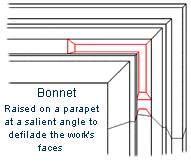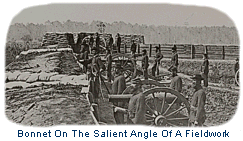 In
permanent fortifications bonnets were outworks consisting of two short faces
positioned in front of the salient angles of demi-lunes or bastions. Bonnets
were generally employed in connection with lunettes. The purpose of this
work was to add depth to the fortification by interposing a secondary outwork
between the demi-lune and covered way. An attack force would necessarily
be compelled to attack and establish a lodgment on the bonnet to be able
to reach the salient of the demi-lune. Both the faces and interior of the
bonnet was flanked and defended by the lunettes so that any lodgment at the
salient of the bonnet would be subject to crossing fire along with direct
fire from the salient of the demi-lune and an oblique fire from its faces. In
permanent fortifications bonnets were outworks consisting of two short faces
positioned in front of the salient angles of demi-lunes or bastions. Bonnets
were generally employed in connection with lunettes. The purpose of this
work was to add depth to the fortification by interposing a secondary outwork
between the demi-lune and covered way. An attack force would necessarily
be compelled to attack and establish a lodgment on the bonnet to be able
to reach the salient of the demi-lune. Both the faces and interior of the
bonnet was flanked and defended by the lunettes so that any lodgment at the
salient of the bonnet would be subject to crossing fire along with direct
fire from the salient of the demi-lune and an oblique fire from its faces.
 In
field fortifications and the earthwork portions of permanent fortifications
a shaped mound raised on the superior slope of a parapet was also called
a bonnet. This type of bonnet was often constructed at salient angles to
defilade adjoining faces from enfilade fire. Bonnets were also employed on
the superior slopes of barbette batteries to provide a measure of protection In
field fortifications and the earthwork portions of permanent fortifications
a shaped mound raised on the superior slope of a parapet was also called
a bonnet. This type of bonnet was often constructed at salient angles to
defilade adjoining faces from enfilade fire. Bonnets were also employed on
the superior slopes of barbette batteries to provide a measure of protection
 for
artillerists who were otherwise very much exposed to enemy fire. In this
case bonnets were positioned far enough apart to allow guns arming the barbette
a wide field of fire, but close enough to the gun positions to give artillerists
cover to duck behind when necessary without having to abandon their guns. for
artillerists who were otherwise very much exposed to enemy fire. In this
case bonnets were positioned far enough apart to allow guns arming the barbette
a wide field of fire, but close enough to the gun positions to give artillerists
cover to duck behind when necessary without having to abandon their guns. |